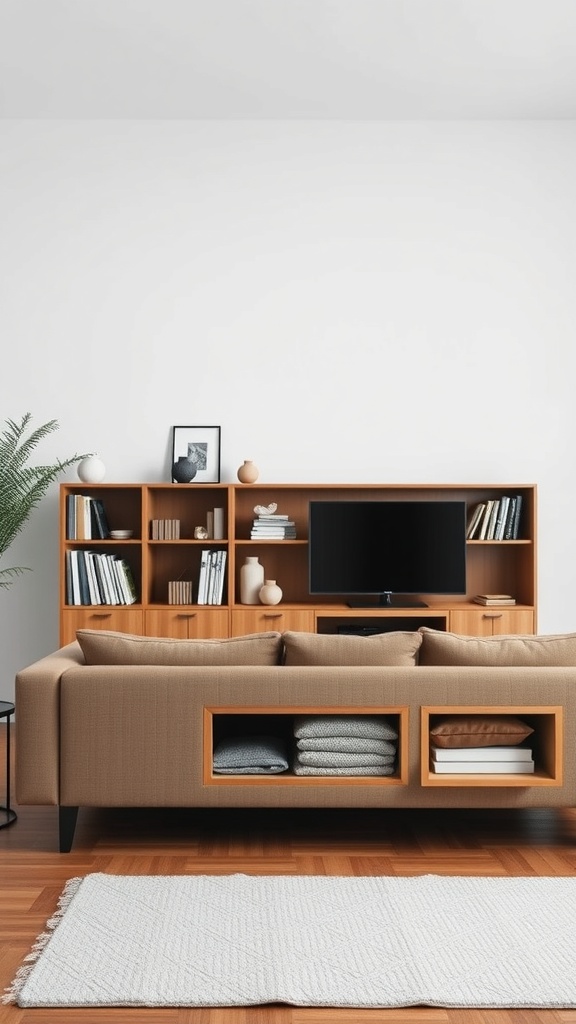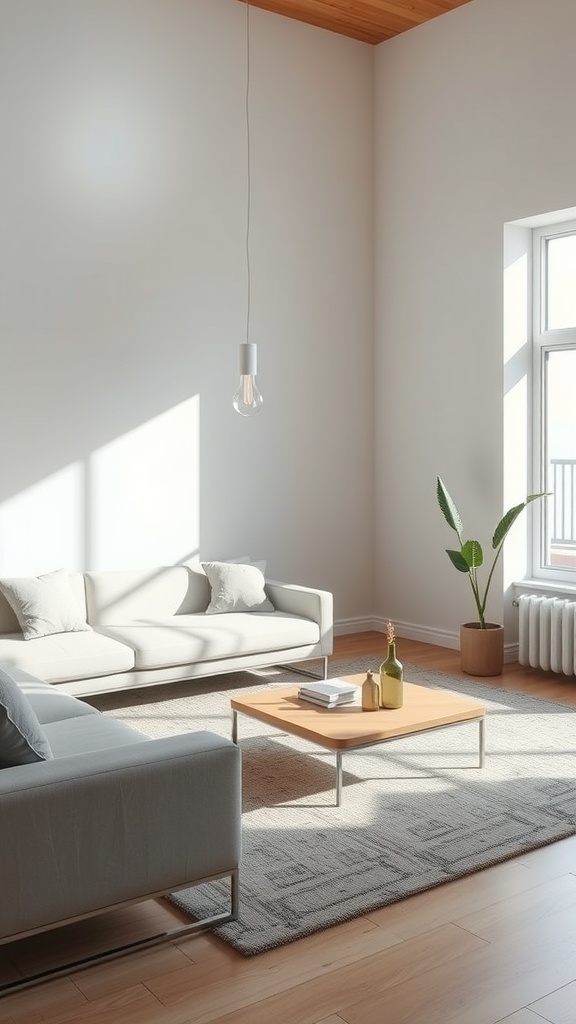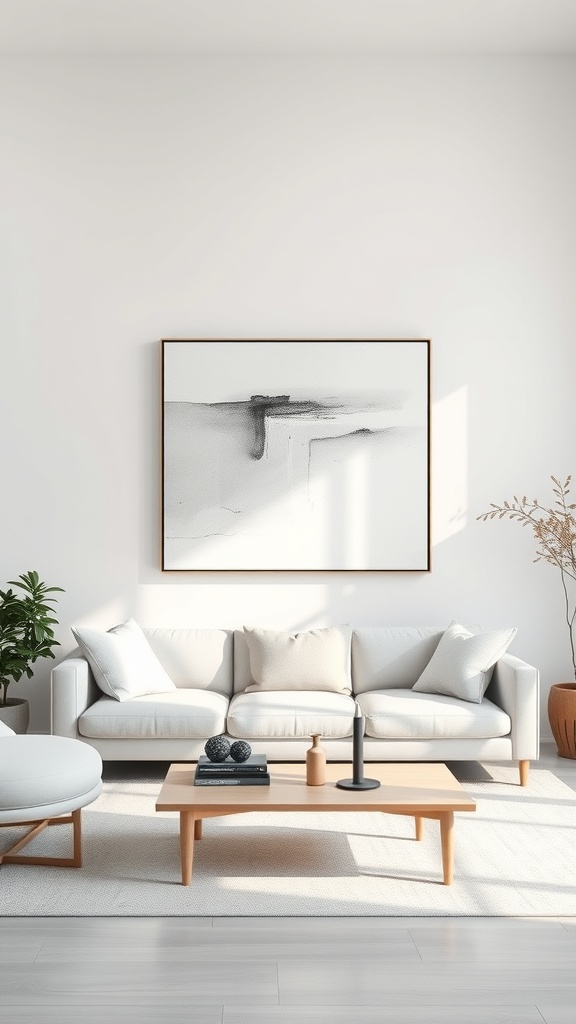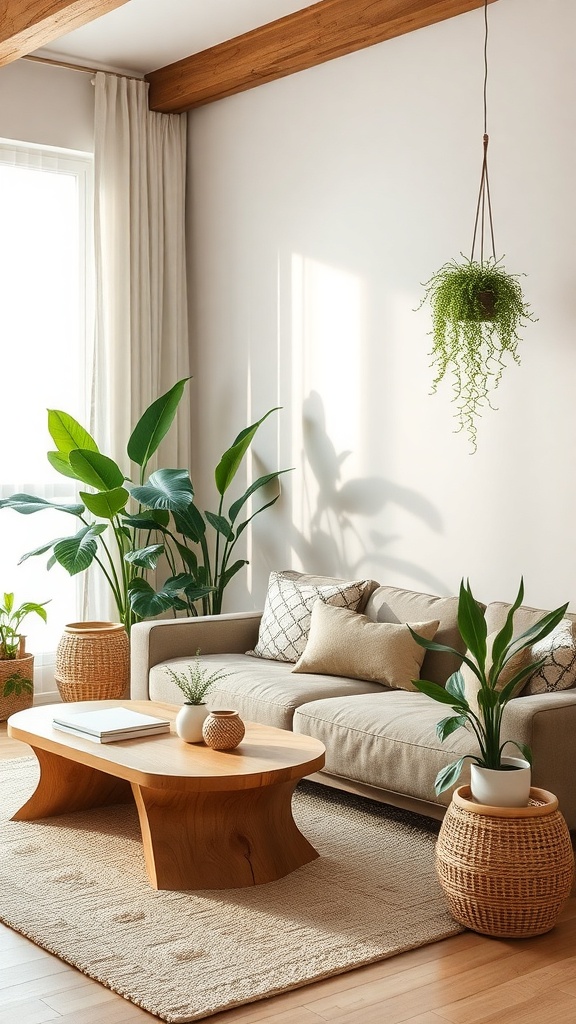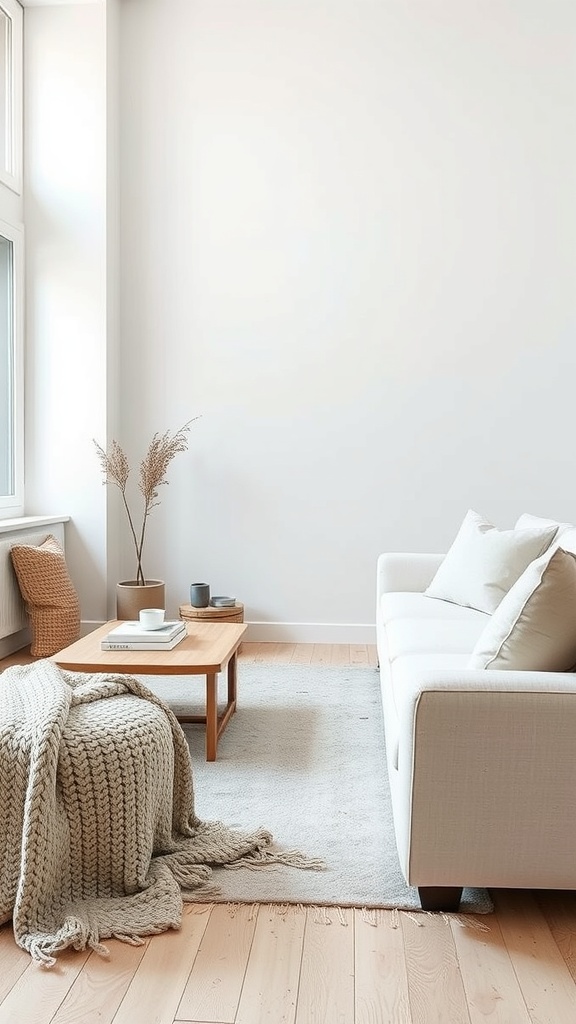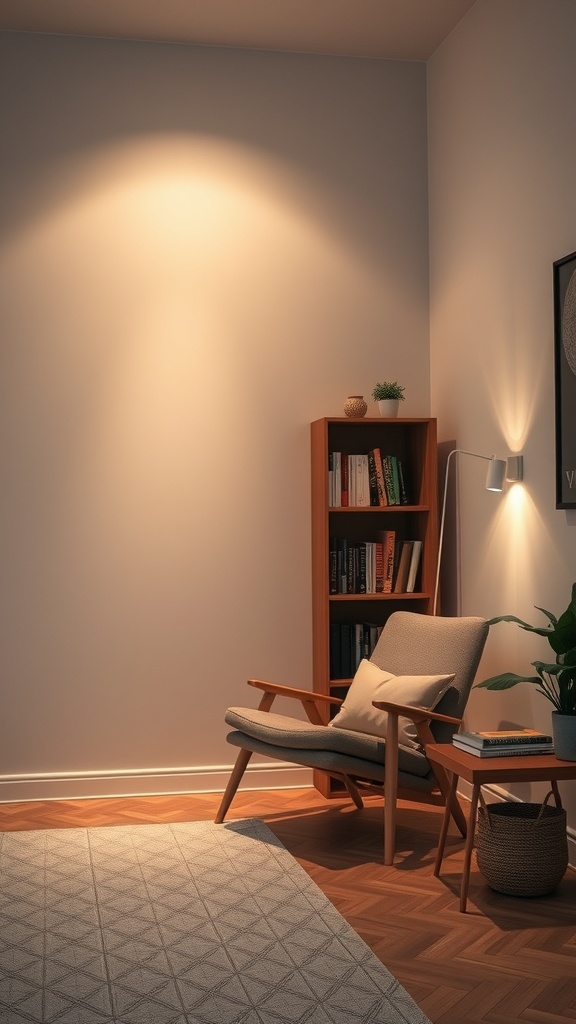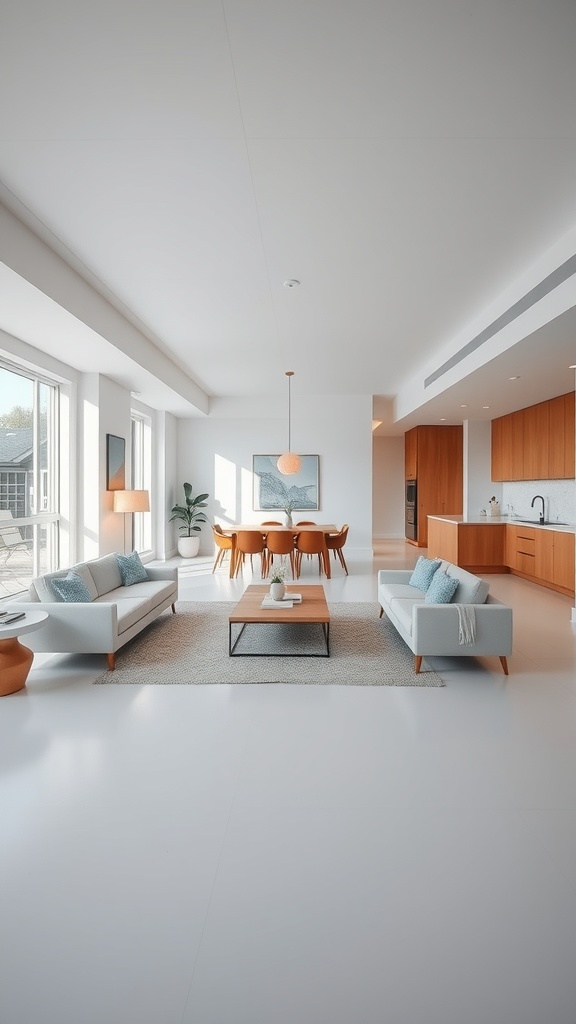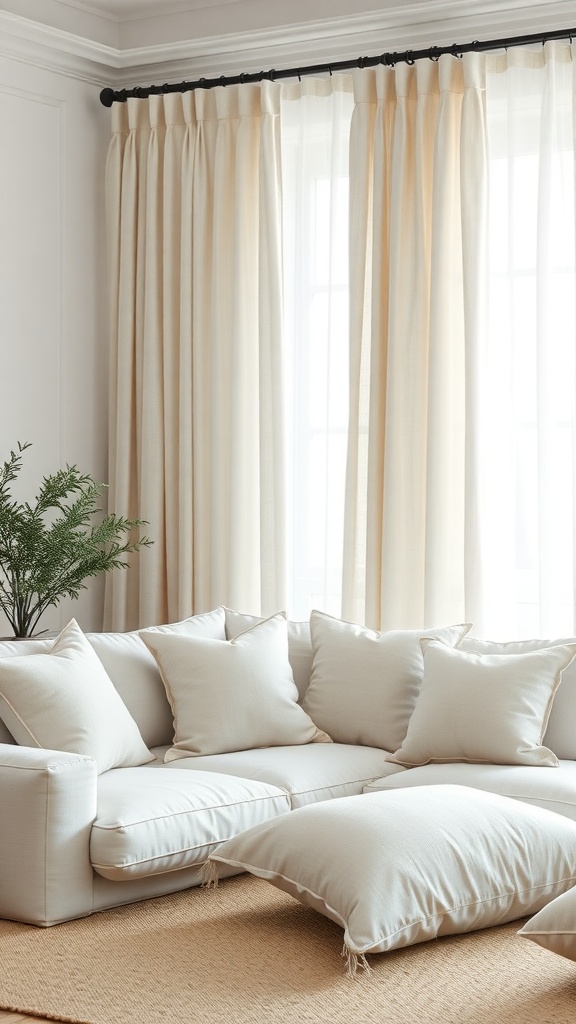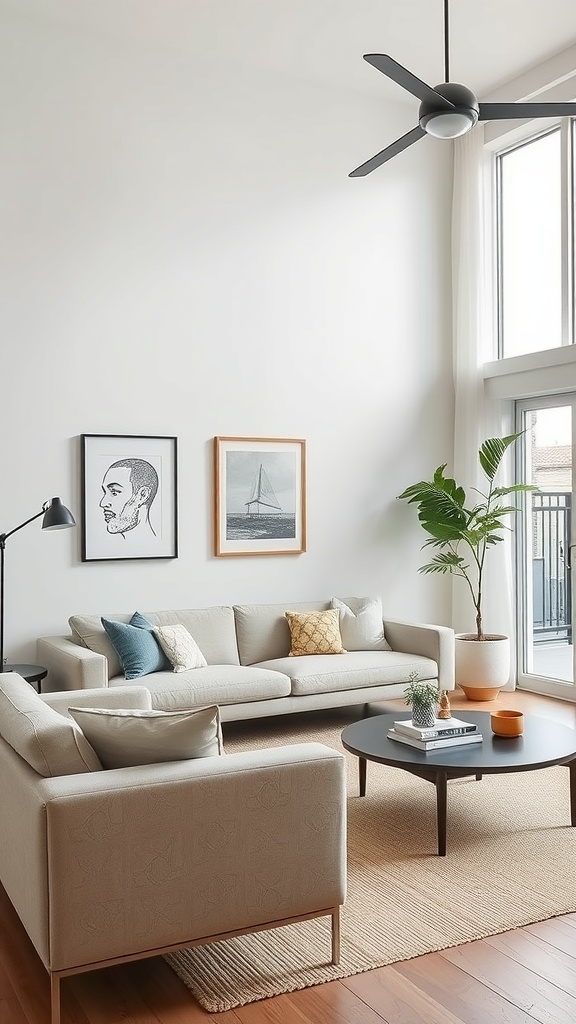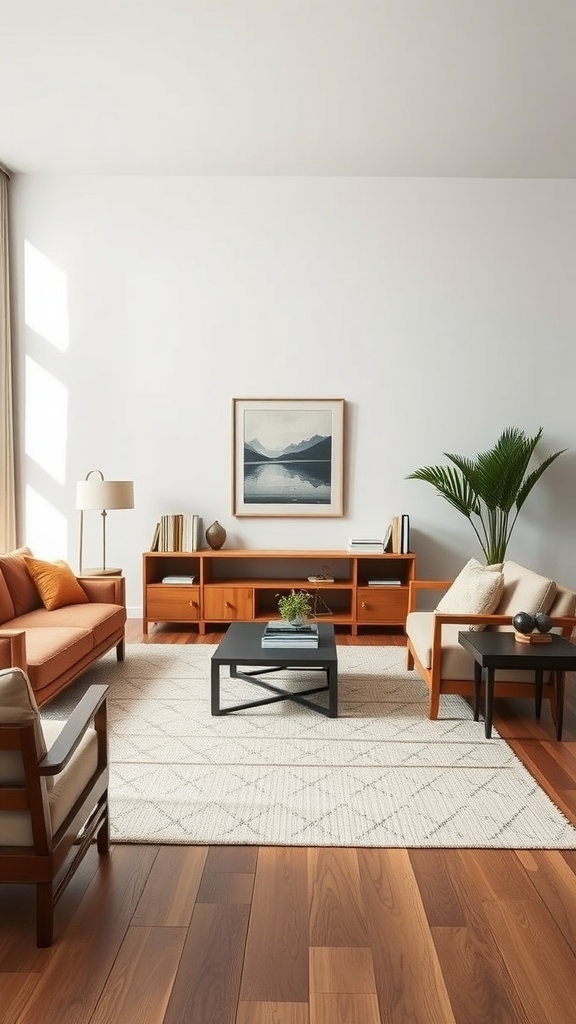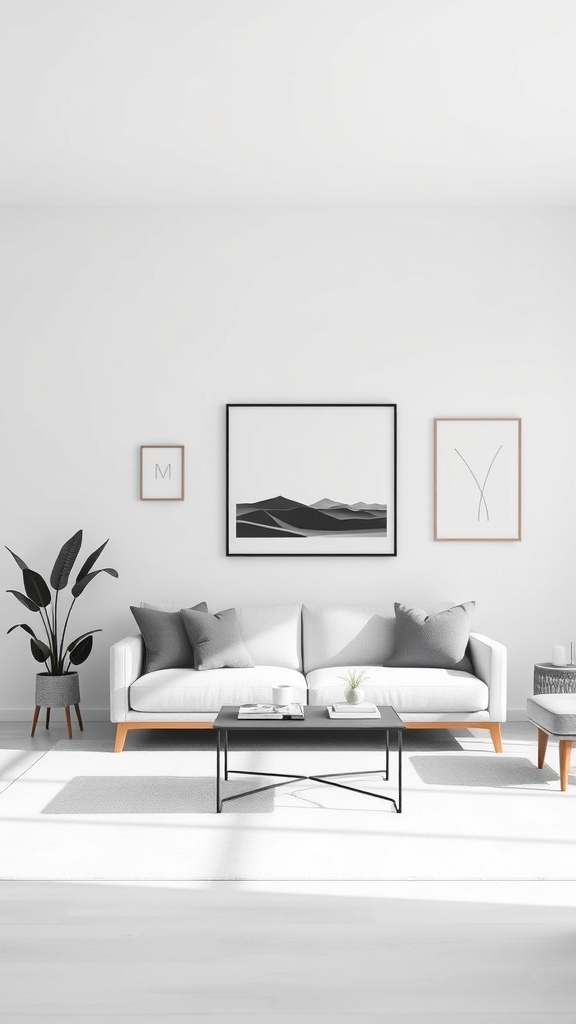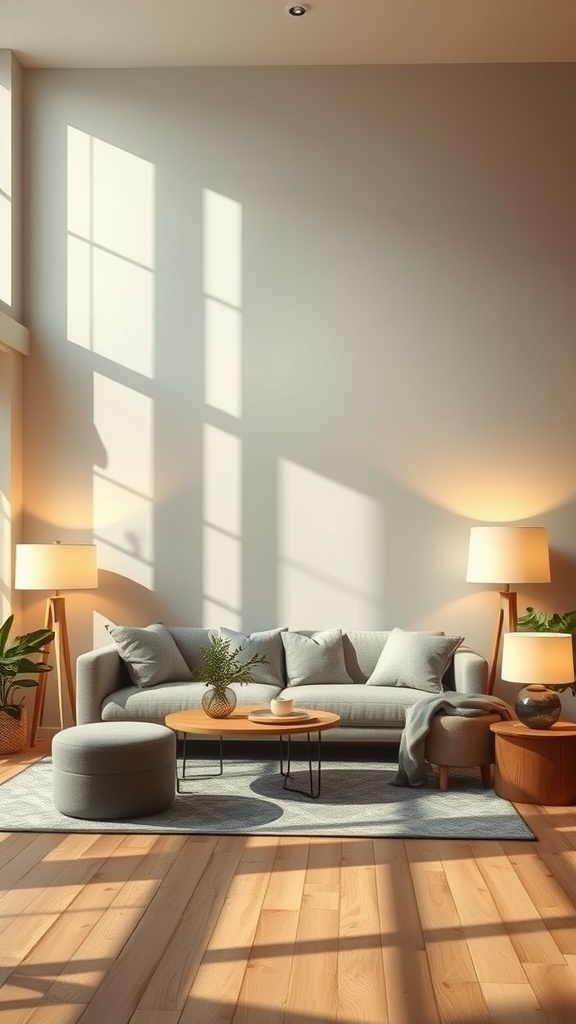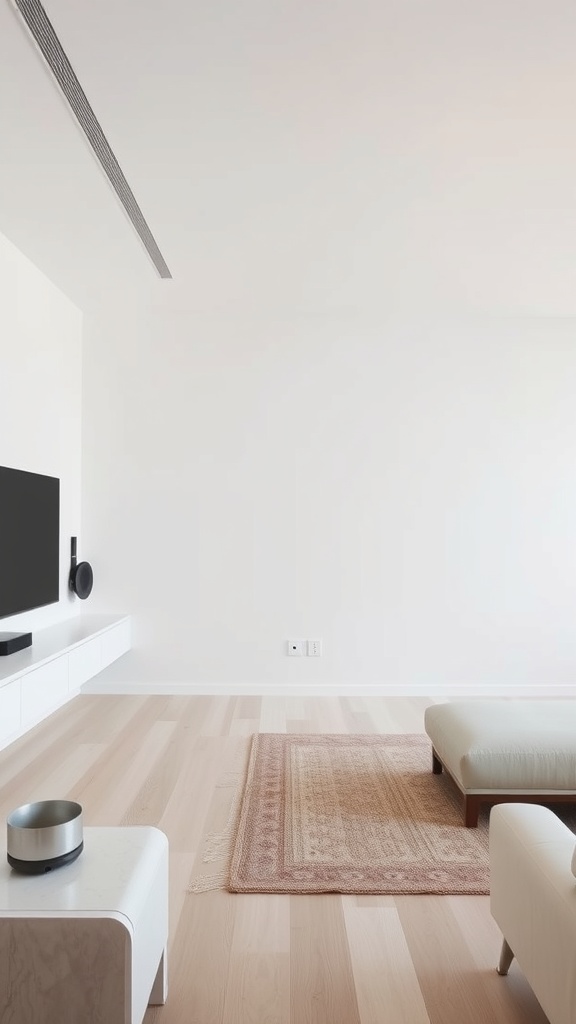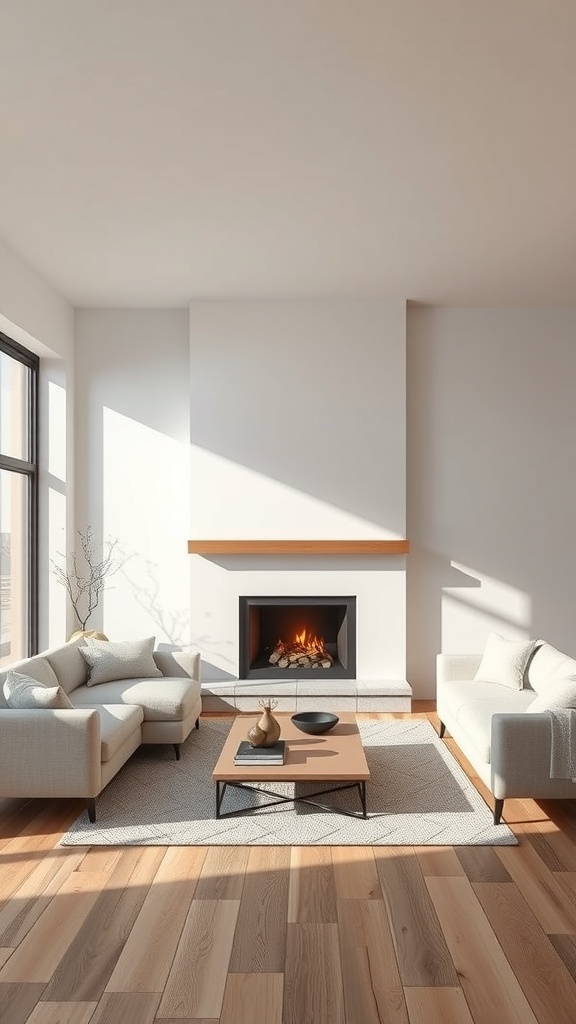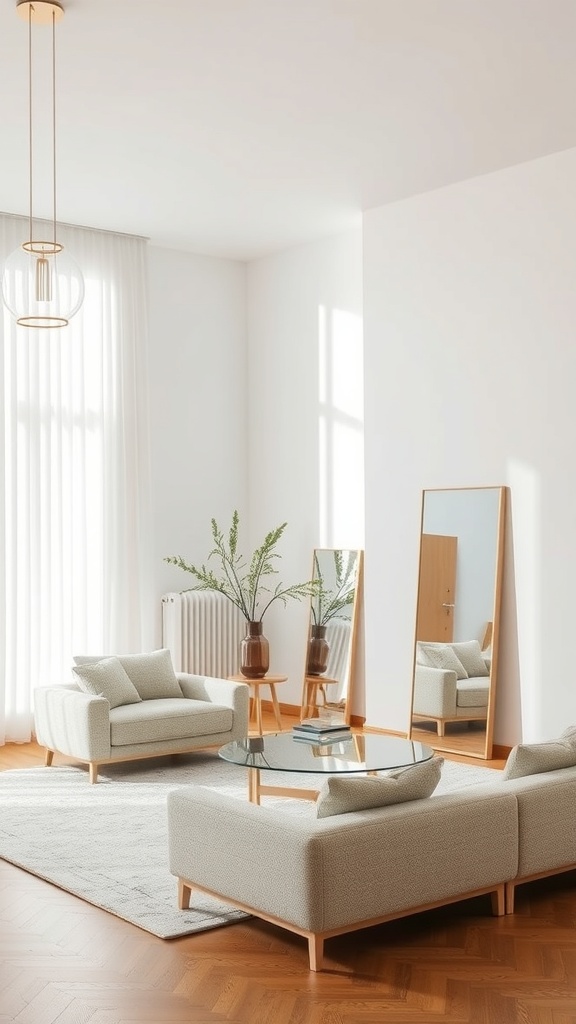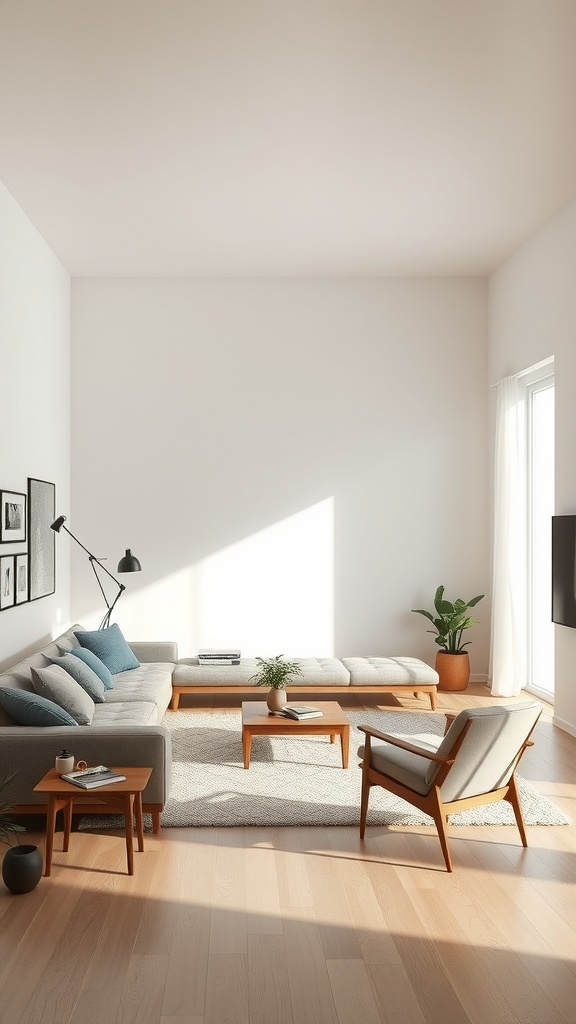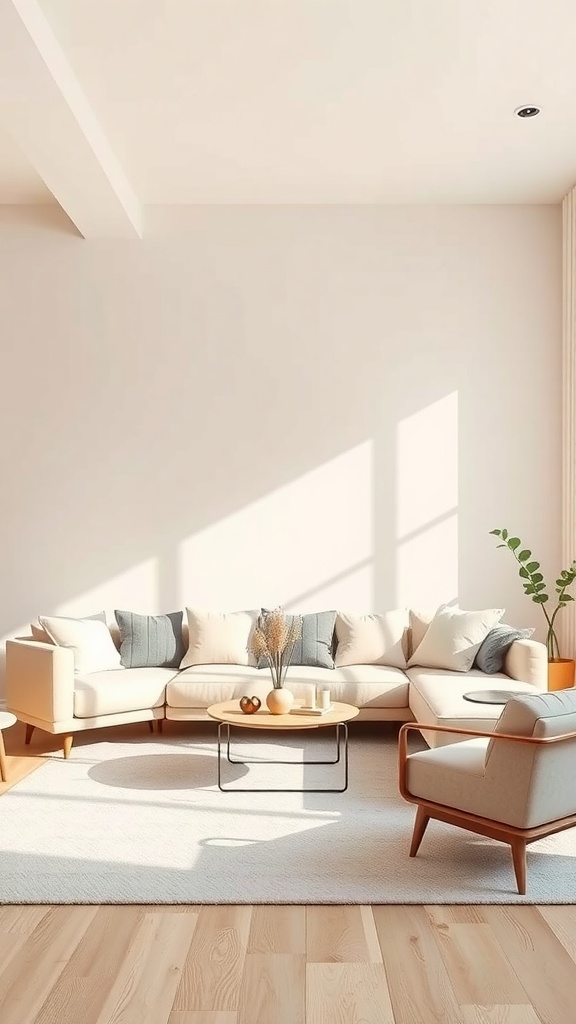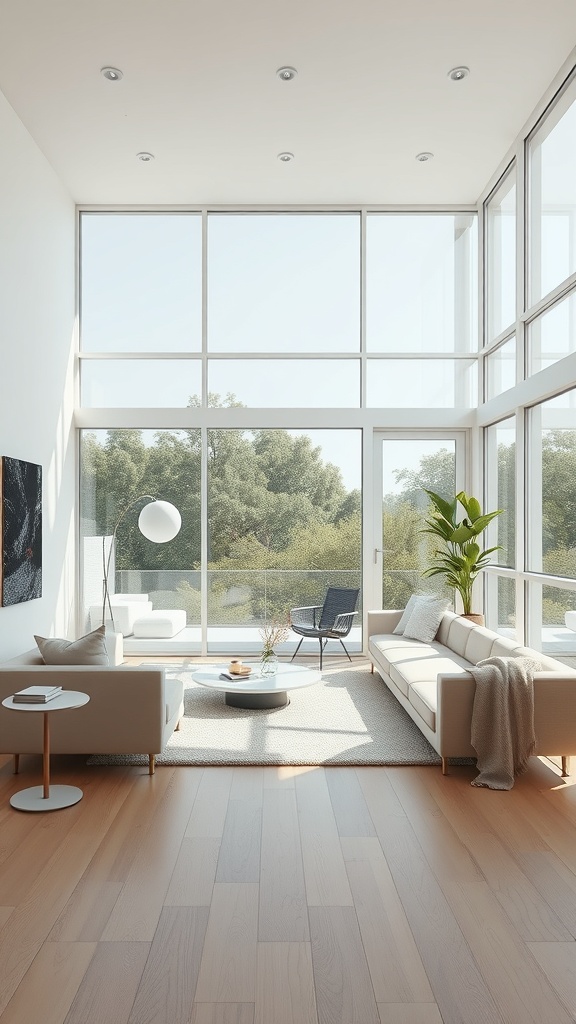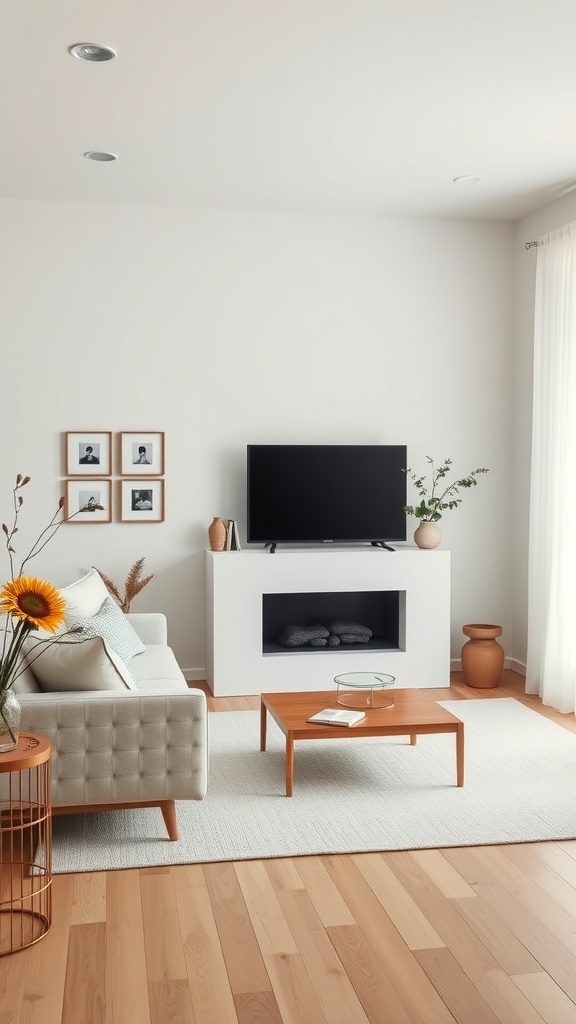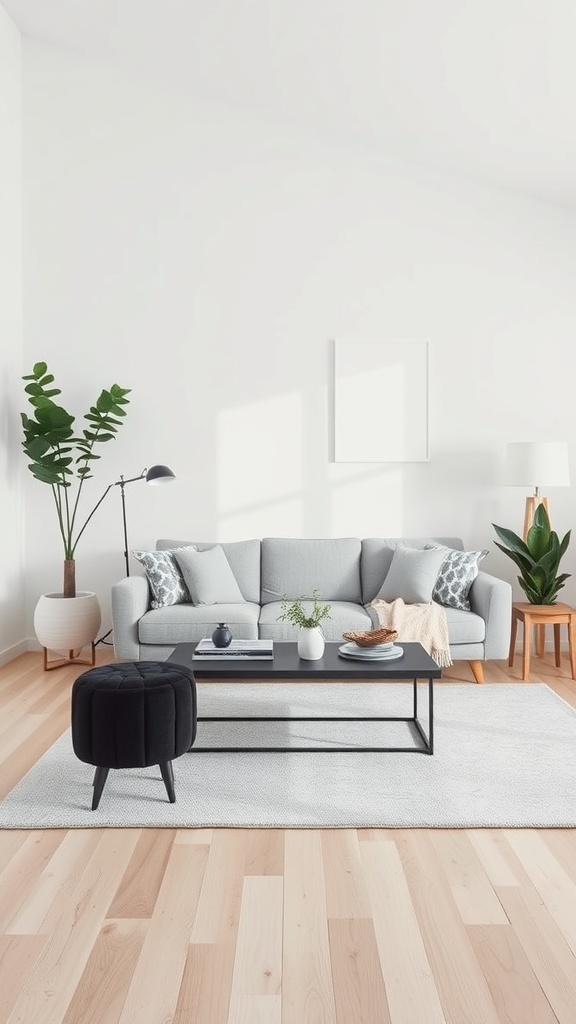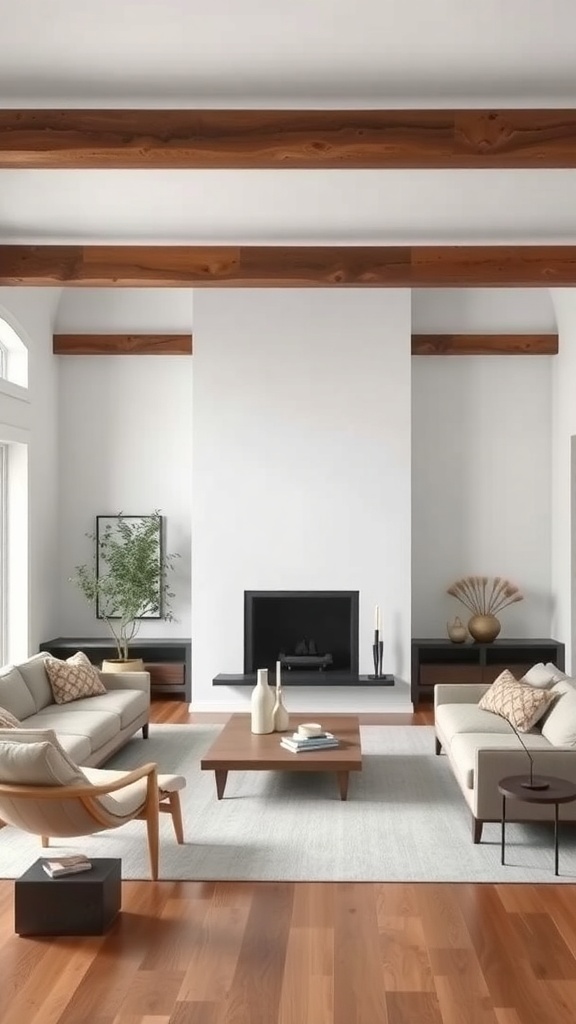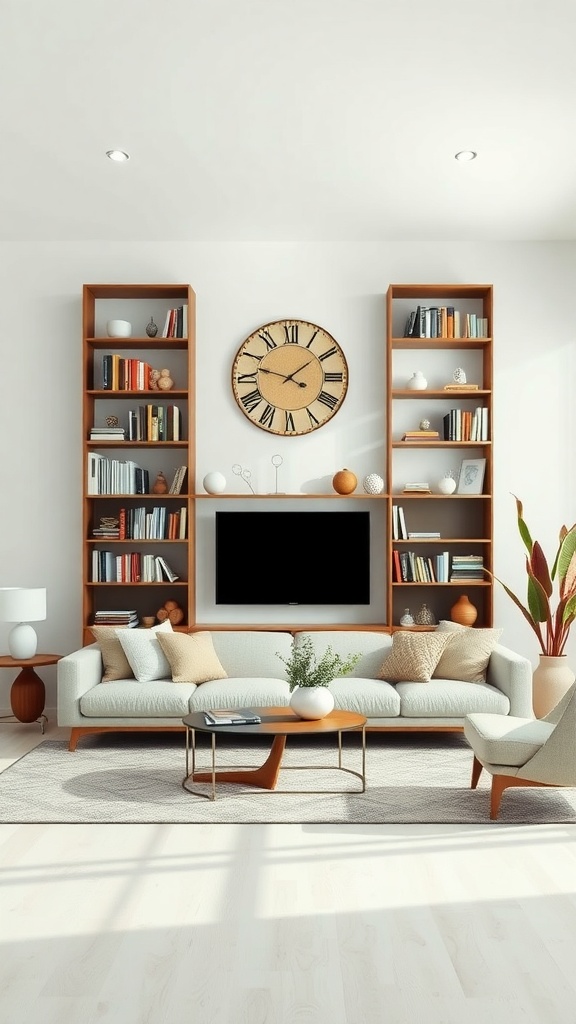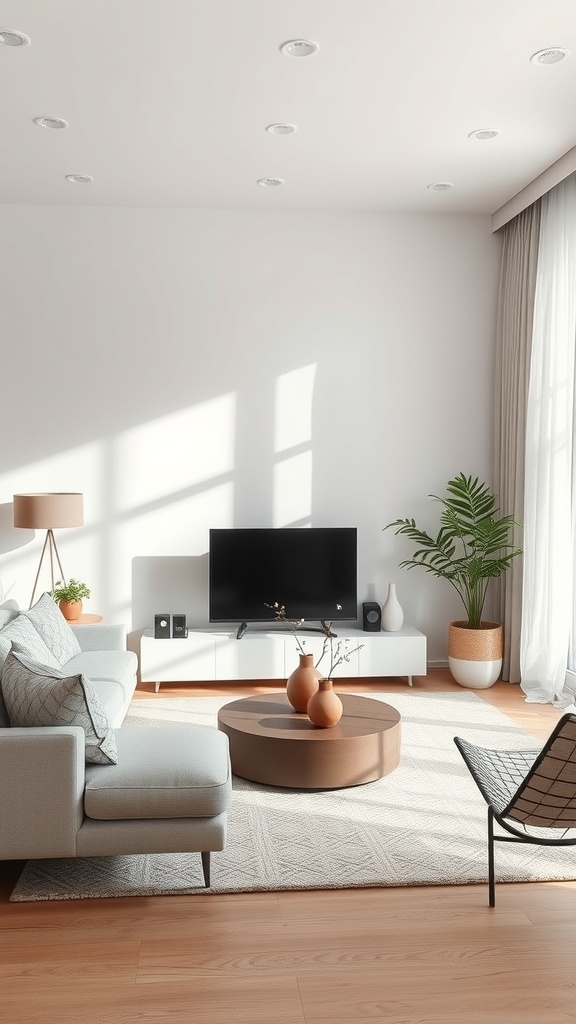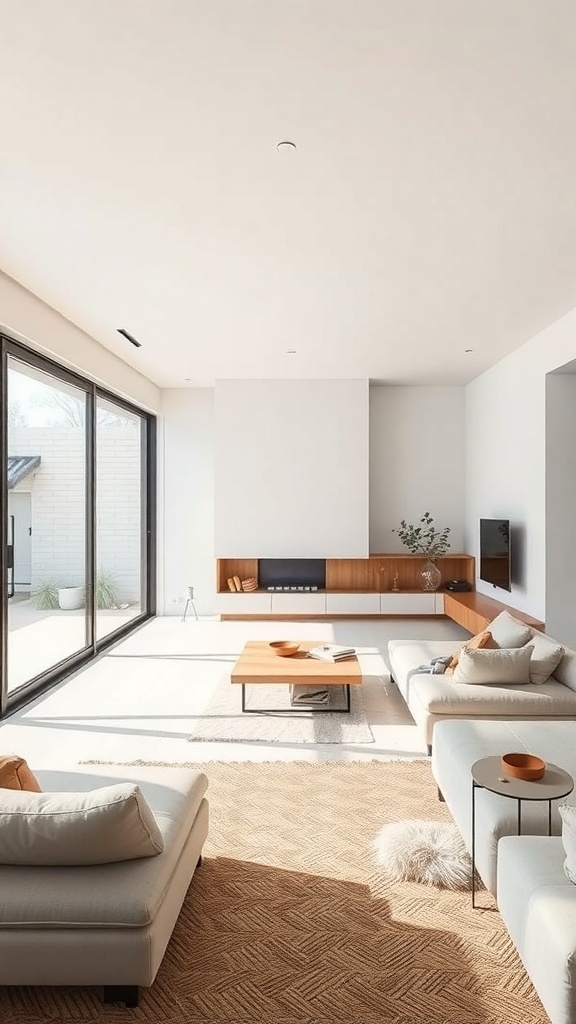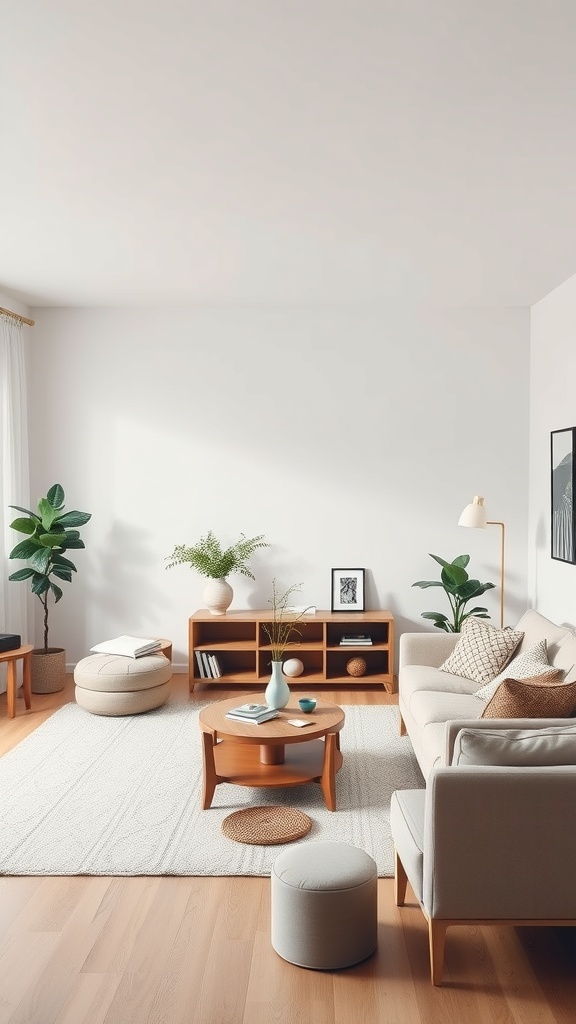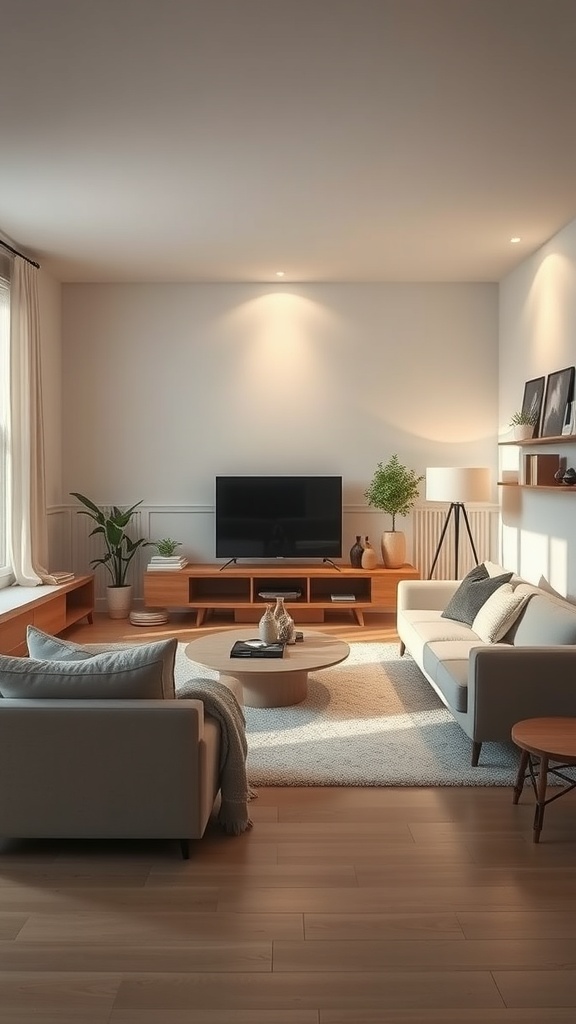Minimalist living rooms focus on simplicity and functionality, creating a calm space free from clutter. With clean lines and essential furnishings, this design style emphasizes a few key pieces that serve a purpose while also looking great. The result is a modern, inviting area perfect for relaxation and socializing, without overwhelming distractions.
Maximizing Space with Smart Storage
In a minimalist living room, every piece of furniture serves a purpose. The image showcases a stylish sofa paired with a clever storage unit. This setup not only looks good but also keeps the space organized.
The sofa features open compartments, perfect for storing blankets and cushions. This design choice keeps essentials close at hand while maintaining a clean look. The warm wood tones of the storage unit add a cozy feel, making the room inviting.
Above the sofa, the shelving unit is a great way to display books and decorative items. It draws the eye upward, creating an illusion of height in the room. This clever use of vertical space is essential in smaller areas.
Overall, smart storage solutions like these help maximize space without sacrificing style. They make the living room functional and enjoyable, proving that minimalist design can be both practical and beautiful.
Functional Furniture Choices
In a minimalist living room, every piece of furniture serves a purpose. The image showcases a simple yet stylish setup with a light-colored sofa and a sleek coffee table. This choice keeps the space open and inviting.
The sofa is designed for comfort without overwhelming the room. Its clean lines and neutral color blend seamlessly with the light wood flooring and warm ceiling. This creates a cozy atmosphere that feels both modern and welcoming.
The coffee table adds functionality while maintaining the minimalist aesthetic. Its light wood finish complements the sofa and provides a surface for drinks or books without cluttering the space. The arrangement encourages relaxation and conversation.
Natural elements, like the potted plant, bring life to the room. This touch of greenery adds a refreshing vibe, making the space feel more connected to nature. Overall, these furniture choices highlight the beauty of simplicity while ensuring the living room remains practical.
Artful Simplicity in Decor
In a minimalist living room, artful simplicity shines through every detail. The soft, neutral tones of the furniture create a calm atmosphere. A cozy white sofa invites relaxation, while the carefully chosen cushions add a touch of comfort.
The centerpiece is a sleek coffee table, showcasing a few decorative items. A simple candle and a stylish vase bring warmth without overwhelming the space. This approach highlights the beauty of less, allowing each piece to stand out.
The wall art above the sofa is a striking black-and-white piece. Its abstract design adds character and draws the eye, making it a focal point without being too loud. This balance of elements creates a serene environment, perfect for unwinding.
A touch of greenery from the potted plant adds life to the room. It complements the overall decor while enhancing the feeling of tranquility. This minimalist approach shows that simplicity can be both functional and beautiful.
Incorporating Natural Elements
In a minimalist living room, natural elements play a key role in creating a calming space. The image showcases a cozy seating area with a light-colored sofa, surrounded by lush green plants. These plants not only add color but also bring a sense of life into the room.
The large windows allow plenty of sunlight to flood in, enhancing the natural vibe. Sunlight streaming through the windows creates beautiful patterns on the floor, making the space feel warm and inviting. The wooden coffee table adds a touch of warmth, contrasting nicely with the soft textures of the sofa and rug.
Incorporating natural materials, like the jute rug and wooden furniture, helps to keep the space grounded. The simple decor, including a few decorative items on the table, maintains the minimalist aesthetic while still feeling personal and welcoming. This balance of simplicity and nature creates a peaceful retreat in your home.
Layering Textures for Depth
Creating a minimalist living room is all about simplicity, but that doesn’t mean it has to feel flat. Layering textures can add depth and warmth to the space, making it inviting and cozy.
In the image, you can see a soft, knitted throw draped over the edge of a light-colored sofa. This adds a tactile element that contrasts nicely with the smooth fabric of the couch. The throw invites you to snuggle up and relax.
The wooden coffee table introduces a natural texture that complements the soft rug beneath it. The combination of materials creates a balanced look. The light wood adds warmth to the room, while the rug softens the space.
Don’t forget about decorative elements like the dried plants in a vase. They bring a touch of nature indoors and add visual interest without overwhelming the minimalist aesthetic. Each texture plays a role in creating a harmonious environment.
Creating a Cozy Nook
A cozy nook in your minimalist living room can be a perfect spot to unwind. This space is all about simplicity and comfort. Picture a stylish armchair placed near a warm light source, inviting you to sit down with a good book or a cup of tea.
The wooden bookshelf adds a touch of warmth and functionality. It holds your favorite reads, making it easy to grab a book whenever you want to relax. A small side table next to the chair is perfect for placing your drink or a small plant, bringing a bit of nature indoors.
The soft rug underfoot adds texture and comfort, making the nook feel even more inviting. The overall design is clean and uncluttered, allowing you to focus on what truly matters: relaxation and enjoyment.
Embracing Neutral Color Palettes
Neutral color palettes create a calm and inviting atmosphere in a minimalist living room. The soft hues of beige, gray, and white blend seamlessly, making the space feel open and airy.
In the image, the light-colored walls and wooden flooring enhance the natural light streaming in through the large windows. This bright, sunlit space feels welcoming and serene, perfect for relaxation.
The furniture choices are simple yet stylish. A light gray sofa paired with soft cushions adds comfort without overwhelming the room. The minimalistic coffee table and side table maintain the clean lines that define minimalist design.
Plants and subtle decor elements bring a touch of nature indoors, adding warmth to the neutral palette. This balance of colors and textures creates a harmonious living space that feels both modern and cozy.
Utilizing Open Floor Plans
Open floor plans are a fantastic way to create a spacious feel in your living room. The image showcases a minimalist living room that perfectly embodies this concept. With large windows letting in natural light, the space feels airy and inviting.
The furniture is arranged to promote conversation and connection. Two light-colored sofas face each other, creating a cozy area for family and friends to gather. The coffee table in the center adds functionality without overwhelming the space.
Adjacent to the living area, a dining table is visible, seamlessly integrated into the design. This setup encourages a flow between the kitchen and living room, making it easy to entertain guests or enjoy family meals.
Minimal decor keeps the focus on the open layout. A few decorative pillows and a simple rug add warmth without cluttering the space. The overall design emphasizes simplicity and comfort, making it an ideal choice for those who appreciate minimalist aesthetics.
Incorporating Minimalist Textiles
Textiles play a key role in creating a minimalist living room. The image showcases a cozy, inviting space with soft, neutral tones. The large, plush sofa is adorned with simple, textured cushions that add comfort without overwhelming the design.
The curtains are light and airy, allowing natural light to filter through while maintaining privacy. Their subtle color gradient from white to a soft beige complements the overall aesthetic, enhancing the room’s serene vibe.
Using textiles in a minimalist way means choosing pieces that are functional yet stylish. The focus should be on quality over quantity. Opt for fabrics that feel good to the touch and add warmth to the space.
Incorporating natural materials, like cotton or linen, can elevate the look. These fabrics not only look great but also contribute to a calming atmosphere. Keep patterns simple or go for solid colors to maintain that clean, uncluttered feel.
Selecting Multi-Functional Pieces
In a minimalist living room, every piece of furniture should serve a purpose. The image shows a cozy setup with a stylish sofa, a coffee table, and a few accent pieces. Each item is chosen not just for looks, but for functionality.
The sofa is inviting and offers comfort, while the coffee table doubles as a surface for drinks or books. Notice how the side table fits perfectly, providing extra space without crowding the room. This kind of thoughtful selection helps maintain an open feel.
When picking furniture, think about how each piece can do more than one job. A storage ottoman can serve as both seating and a place to stash items. This approach keeps the space tidy and organized, which is key in minimalist design.
Lastly, don’t forget about the lighting. A floor lamp can brighten up the room while adding style. Choosing multi-functional pieces like these makes your living room both practical and stylish.
Balancing Functionality and Aesthetics
A minimalist living room strikes a balance between functionality and aesthetics. In this space, simplicity reigns, allowing each piece to shine without overwhelming the senses.
The light-colored walls and wooden flooring create a warm backdrop. The furniture is sleek and practical, with a focus on comfort. The two sofas invite relaxation, while the low coffee table provides a perfect spot for drinks or books.
Decorative elements, like the green plants and carefully chosen art, add personality without cluttering the space. The use of natural light enhances the room’s openness, making it feel airy and inviting.
Overall, this living room showcases how thoughtful design can create a space that is both beautiful and functional, perfect for everyday living.
Choosing Statement Lighting Fixtures
In a minimalist living room, lighting plays a key role in setting the mood. The image shows a clean and simple space with a striking pendant light that draws the eye. This fixture not only illuminates the room but also adds a touch of personality.
When selecting lighting, think about how it complements your furniture and decor. The light in the image has a warm glow that enhances the cozy feel of the sofa and the natural elements around it. Choosing a statement piece can transform a basic room into a stylish haven.
Consider the height and placement of your lighting. The pendant light here hangs gracefully, creating a focal point without overwhelming the space. It’s all about balance. Pairing it with recessed lighting helps to maintain a clean look while providing ample light.
Don’t forget about functionality. The right light fixture should not only look good but also serve its purpose. Whether you need bright light for reading or soft light for relaxation, your choice should reflect your lifestyle.
Focusing on Quality Over Quantity
In a minimalist living room, the focus is on quality over quantity. Each piece of furniture and decor serves a purpose and adds to the overall feel of the space. For instance, the warm tones of the wooden furniture create a cozy atmosphere, while the simple lines keep things clean and uncluttered.
The arrangement of the seating encourages conversation and relaxation. A well-placed lamp adds soft lighting, making the room inviting without overwhelming it. The artwork on the wall is thoughtfully chosen, adding character without crowding the space.
Plants bring a touch of nature indoors, enhancing the room’s tranquility. This approach shows that you don’t need a lot of items to create a beautiful living area. Instead, selecting a few high-quality pieces can transform your space into a serene retreat.
Incorporating Minimalist Artwork
Minimalist living rooms shine when paired with the right artwork. The image showcases a clean, bright space featuring a simple yet striking black and white landscape painting. This piece draws the eye without overwhelming the room.
On the walls, you can spot smaller framed pieces that add character. The subtle touches of art complement the overall aesthetic, enhancing the minimalist vibe. Each frame is thoughtfully chosen, ensuring a cohesive look.
The furniture in the room is equally minimal, with a sleek sofa and a simple coffee table. This setup allows the artwork to take center stage, creating a harmonious balance. Plants add a touch of life, breaking the monotony while keeping the space airy.
When selecting artwork for a minimalist living room, aim for pieces that evoke calmness and simplicity. Black and white art, abstract designs, or even a single bold color can work wonders. Remember, less is often more in minimalist design.
Choosing the Right Flooring
When it comes to creating a minimalist living room, the flooring plays a big role in setting the tone. The image shows a sleek, modern space with warm wooden floors that add a touch of elegance. This choice of flooring complements the minimalist style, making the room feel open and inviting.
Wooden floors are a great option for minimalist designs. They provide a natural look that blends well with various decor elements. The light color of the wood in the image enhances the brightness of the room, reflecting natural light from the large windows.
Another benefit of wooden flooring is its versatility. It pairs nicely with different furniture styles, as seen with the simple couch and stylish coffee table. This allows you to change up your decor without worrying about the flooring clashing.
When selecting flooring, think about maintenance too. Wooden floors are relatively easy to clean and can last for years with proper care. This makes them a practical choice for a living room that you want to keep looking fresh and modern.
Creating a Calm Atmosphere with Lighting
Lighting plays a key role in setting the mood of a minimalist living room. In the image, natural light floods the space through large windows, creating a warm and inviting feel. The soft shadows cast on the walls add depth without overwhelming the simplicity of the design.
Table lamps with soft, warm bulbs complement the natural light. They provide a cozy glow, perfect for evenings when you want to unwind. The combination of natural and artificial light helps create a balanced atmosphere.
Incorporating plants adds a touch of life and freshness. The greenery contrasts beautifully with the neutral tones of the furniture and walls. This mix not only enhances the calm vibe but also brings a bit of nature indoors.
Overall, the thoughtful use of lighting in this minimalist living room transforms it into a serene retreat. It encourages relaxation and makes the space feel more inviting.
Integrating Technology Seamlessly
In a minimalist living room, technology blends effortlessly with the decor. The sleek lines of the furniture and the clean surfaces create a calm environment. A wall-mounted TV sits above a low-profile media console, keeping the space tidy and organized.
The use of a simple color palette enhances the modern feel. The soft tones of the furniture complement the light wood flooring, making the room feel open and inviting. A smart speaker on the console adds functionality without cluttering the space.
Lighting is another key aspect. Recessed ceiling lights provide a warm glow, while the minimalist design keeps the focus on the room’s simplicity. This setup allows for easy control of ambiance, making it perfect for relaxing evenings.
Overall, integrating technology in a minimalist living room is about keeping things simple yet functional. The goal is to create a space that feels both modern and comfortable, where every piece serves a purpose.
Incorporating a Focal Point
In a minimalist living room, creating a focal point is key to achieving a balanced and inviting space. The image showcases a cozy setup with a fireplace that draws the eye immediately. This feature not only adds warmth but also serves as a natural gathering spot for family and friends.
The arrangement of the furniture complements the focal point beautifully. The two light-colored sofas are positioned to face the fireplace, encouraging conversation and connection. A simple coffee table sits in the center, adding functionality without cluttering the space.
Natural light floods the room through large windows, enhancing the serene atmosphere. The soft tones of the walls and flooring work together to create a calming backdrop, allowing the focal point to shine without overwhelming the senses.
Incorporating elements like a stylish vase or a decorative bowl on the coffee table can add personality without detracting from the minimalist theme. This approach keeps the focus on the fireplace while still allowing for personal touches.
Using Mirrors to Enhance Space
Mirrors are a fantastic tool in minimalist design. They can make a room feel larger and brighter, which is perfect for a cozy living room. In the image, the large mirror reflects light and adds depth to the space.
The light-colored furniture and soft textures create a calm atmosphere. The mirror complements this by bouncing light around, making the room feel airy. A well-placed mirror can also highlight beautiful decor, like the stylish plant in the vase.
When choosing a mirror, consider its shape and frame. A simple, sleek design fits well in a minimalist setting. It can serve as a focal point without overwhelming the space. Mirrors can also be used to create interesting visual lines, drawing the eye around the room.
In this living room, the mirror not only enhances the space but also adds a touch of elegance. It’s a practical choice that combines function and style, making it a must-have for any minimalist home.
Creating Zones for Different Activities
In a minimalist living room, creating distinct zones can enhance both functionality and comfort. This image showcases a well-organized space that clearly defines areas for relaxation, socializing, and even work. The layout is simple yet effective, making it easy to enjoy various activities without feeling cluttered.
The cozy sofa, adorned with soft cushions, invites you to unwind. Nearby, a sleek coffee table holds books and a plant, perfect for casual chats or enjoying a cup of tea. The light streaming in from the window adds warmth, making this area feel welcoming.
On the opposite side, a stylish chair offers a quiet spot for reading or working. This separation allows for different moods and activities, ensuring that everyone can find their own space within the room. By using furniture to create these zones, you can maintain a minimalist aesthetic while still catering to your lifestyle needs.
Incorporating Minimalist Shelving
Minimalist shelving is a fantastic way to keep your living room tidy and stylish. The image shows a sleek shelving unit that blends seamlessly with the room’s design. The light wood tones and simple lines create a calming effect.
Each shelf holds carefully chosen items, like books and decorative pieces. This approach prevents clutter and keeps the focus on what really matters. A few well-placed accessories, such as a clock and a vase, add personality without overwhelming the space.
Plants also play a key role in minimalist design. The green leaves of the plant next to the shelf bring life into the room. They contrast nicely with the neutral colors, making the space feel fresh and inviting.
When choosing shelves, consider both function and form. Open shelving allows you to display your favorite items while keeping everything organized. This balance is essential in a minimalist living room.
Creating a Harmonious Color Scheme
In a minimalist living room, the color scheme plays a key role in creating a peaceful atmosphere. The image showcases a soft palette that includes light beige and muted tones. These colors work together to create a calm and inviting space.
The large sectional sofa, adorned with subtle gray and blue cushions, adds a touch of comfort without overwhelming the room. The round coffee table, with its natural wood finish, complements the light flooring and enhances the overall simplicity.
Natural light floods the space, highlighting the clean lines and gentle hues. A few green plants bring a hint of life, balancing the neutral tones with a splash of freshness. This combination of colors and textures creates a harmonious environment, perfect for relaxation.
When choosing colors for your own minimalist living room, think about how they interact with one another. Aim for a cohesive look that promotes tranquility. Soft shades and natural materials can make your space feel open and airy, just like the one in the image.
Designing for Natural Light
Natural light can transform a living space, making it feel larger and more inviting. In this minimalist living room, large windows flood the area with sunlight, creating a warm and airy atmosphere. The open layout allows light to bounce around, enhancing the overall design.
Choosing light-colored furniture and decor complements the natural light beautifully. The soft tones of the sofa and rug harmonize with the wooden floor, adding warmth without overwhelming the space. A few carefully placed plants bring a touch of nature indoors, further connecting the room to its surroundings.
Strategically placing mirrors can also amplify the light. They reflect sunlight, making the room feel even brighter. This minimalist approach keeps the focus on simplicity, allowing the beauty of natural light to shine through.
Adding Personal Touches Thoughtfully
In a minimalist living room, every piece of furniture and decor plays a role. The image shows a cozy space with a light color palette and simple lines. The sofa is inviting, and the wooden coffee table adds warmth to the room.
To make this space feel more personal, consider adding a few carefully chosen items. The framed photos on the wall are a great example. They tell a story without overwhelming the space. You can choose images that reflect your life or interests.
Plants are another fantastic way to bring life into a minimalist room. The greenery adds a fresh touch and can make the environment feel more vibrant. A simple vase with flowers, like the sunflowers shown, can brighten up the area and create a cheerful atmosphere.
Remember, the key is to keep it simple. Choose items that resonate with you and fit the overall aesthetic. This way, your personal touches will enhance the minimalist vibe rather than clutter it.
Incorporating Minimalist Rugs
Rugs play a key role in a minimalist living room. They can add warmth and texture without overwhelming the space. In the image, the soft, light-colored rug complements the light wood flooring and enhances the room’s airy feel.
A minimalist rug should be simple yet stylish. Look for neutral tones or subtle patterns that blend seamlessly with your furniture. The rug in this setting provides a cozy area for the black ottoman and coffee table, creating a defined space for relaxation.
When choosing a rug, consider the size. It should fit well within the seating area, allowing the front legs of the furniture to rest on it. This creates a cohesive look. The rug here anchors the sofa and coffee table, making the room feel inviting.
Don’t forget about maintenance. A rug that is easy to clean is ideal for a minimalist lifestyle. Opt for materials that resist stains and are durable. This way, your rug will stay looking fresh and stylish for years to come.
Using Architectural Features as Decor
In a minimalist living room, architectural features can shine as the main decor elements. The image showcases a space where clean lines and natural materials create a serene atmosphere. The wooden beams on the ceiling add warmth and character, contrasting beautifully with the soft white walls.
The fireplace, framed by a sleek black surround, serves as a focal point. It invites relaxation and gatherings, making it a perfect centerpiece for the room. Simple decor items, like the vases and candles on the mantel, enhance the minimalist vibe without overwhelming the space.
Furniture choices, such as the light-colored sofas and wooden coffee table, complement the architectural features. The arrangement encourages conversation and connection, making the room feel inviting. A touch of greenery from the plant adds life, balancing the clean lines with a natural element.
This approach shows how architectural details can be both functional and decorative. By letting these features stand out, the room feels open and airy, embodying the essence of minimalist design.
Utilizing Vertical Space Effectively
In a minimalist living room, making the most of vertical space is key. The image showcases tall bookshelves that draw the eye upward, creating a sense of height and openness. These shelves not only provide storage but also serve as a stylish display for books and decorative items.
The neutral color palette of the room enhances the feeling of spaciousness. The light walls and furniture allow natural light to bounce around, making the space feel airy. Notice how the clock on the wall adds a focal point without overwhelming the design.
Incorporating plants, as seen in the corner, adds a touch of nature and liveliness. They also help to soften the clean lines of the furniture. Using vertical space effectively means every inch counts, and this setup demonstrates how to do that beautifully.
Incorporating Subtle Patterns
In a minimalist living room, subtle patterns can add depth and interest without overwhelming the space. The image showcases a clean, airy environment with a light color palette. The soft textures of the rug and the geometric design on the cushions introduce a gentle pattern that complements the overall simplicity.
Notice how the round coffee table contrasts with the angular lines of the chair. This mix of shapes creates a visual balance. The plant adds a touch of nature, breaking the monotony and bringing life to the room. Patterns don’t have to be loud; they can be soft and understated, enhancing the minimalist vibe.
Choosing items with subtle patterns allows for a cohesive look. The light streaming in through the windows highlights these details, making the room feel warm and inviting. This approach shows that minimalism doesn’t mean sacrificing personality; it’s about curating a space that feels both stylish and comfortable.
Creating a Seamless Indoor-Outdoor Connection
A minimalist living room can beautifully connect the indoors with the outdoors. The image shows a spacious area filled with natural light, thanks to large glass doors that open up to the outside. This design choice invites the beauty of nature right into your home.
The clean lines and neutral colors of the furniture create a calm atmosphere. The soft textures of the cushions and the warm tones of the rug add comfort, making the space feel inviting. This setup encourages relaxation and social interaction, whether you’re inside or outside.
To enhance this connection, consider adding plants both inside and outside. They can act as a bridge, tying the two spaces together. Simple decor items, like a few well-placed vases or art pieces, can also help maintain a cohesive look.
Overall, a minimalist living room that opens to the outdoors can create a refreshing and serene environment. It’s all about making the most of natural light and creating a flow between spaces.
Maintaining a Clutter-Free Environment
A minimalist living room shines with simplicity and calm. The image showcases a cozy space with soft colors and natural light. A light-colored sofa sits comfortably, paired with a wooden coffee table. The decor is minimal, featuring a few plants and decorative items that add a touch of life without overwhelming the space.
To keep this environment clutter-free, start by choosing furniture that serves multiple purposes. For instance, the round ottoman can double as extra seating or a footrest. This not only saves space but also keeps things tidy. Regularly assess what you have in the room. If an item doesn’t serve a purpose or bring joy, consider letting it go.
Another tip is to establish a routine for tidying up. Spend a few minutes each day putting things back in their place. This small effort can prevent clutter from building up. Use storage solutions like baskets or shelves to keep items organized and out of sight. The open shelving in the image is a great example of how to display a few cherished items while keeping the overall look clean.
Lastly, embrace the idea of less is more. Choose a few key pieces that reflect your style and let them shine. This approach not only enhances the aesthetic but also creates a peaceful atmosphere. A clutter-free living room invites relaxation and makes it easier to enjoy your space.
Creating a Relaxing Ambiance
A minimalist living room can be a perfect retreat from the chaos of everyday life. The image showcases a space that feels open and inviting, with soft lighting and simple furniture. The light colors on the walls and the natural wood elements create a soothing atmosphere.
The furniture is arranged thoughtfully, allowing for easy movement and conversation. The cozy sofas invite you to sit back and unwind. A round coffee table adds a touch of warmth, making it a great spot for drinks or books.
Plants in the corners bring a bit of nature indoors, enhancing the calming vibe. The gentle light from the lamps adds a soft glow, perfect for evenings spent relaxing. This setup encourages you to take a moment for yourself, whether it’s reading a book or enjoying a cup of tea.
Overall, this minimalist approach helps in creating a serene environment. It’s all about keeping things simple and functional while still feeling cozy. A well-designed living room can truly be a sanctuary.

